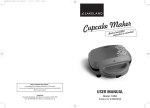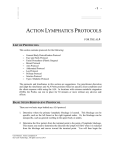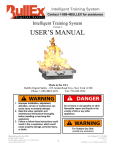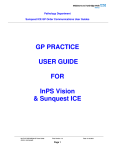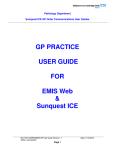Download Venipunture Procedure - Ministry Health Care
Transcript
Ministry Saint Michael’s Hospital Laboratory LABORATORY POLICY AND PROCEDURE TITLE/SUBJECT: FILE NUMBER: ASSIGNED MANUAL: ORIGINATION DATE: EFFECTIVE DATE: DISTRIBUTION: Venipuncture PH001.05 Phlebotomy/Specimen Procurement 6-6-2007 June 26, 2014 All Saint Michaels Hospital Laboratories PRINCIPLE/PURPOSE: To obtain proper blood specimens for Laboratory analysis in the area of Hematology, Chemistry, Coagulation, and Bacteriology for the purpose of aiding in the diagnosis and treatment of illnesses and disorders, monitoring progress and following results of treatment. PATIENT PREPARATION: Some tests may require that the patient fast 8 to 10 hours. Other tests may need to be drawn at a specific time, such as post-dose drug levels or timed glucose testing. See corresponding in-house procedure or reference manual specimen requirements for specific sample requirements SPECIMEN/HANDLING: As determined by tests ordered. Serum, plasma, or whole blood may be required. Refer to SMH blood collection requirements - evacuated tube collection information and specific department/test collection procedures, and recommended order of draw. MATERIALS: No expired supplies are used. Latex free supplies are used whenever possible. Protective safety devices are not removed from equipment. Equipment • • • • • Evacuated tubes and bottles Sterile needles/holders Syringes Transfer devices Winged infusion sets Reagents Supplies • • • • • • • Alcohol wipes Non-alcohol wipes (if medical alcohol is ordered) Bandages/Tape Disposable gloves Gauze Personal Protective equipment Tourniquet PH-001.05 Venipuncture Rev. 1/02/2013 STANDARDS: Saint Michael’s Hospital hand washing and safety policies are monitored for use. CALIBRATION: NA QUALITY CONTROL: NA PROCEDURE: 1.0 Greet patient and explain procedure to be performed. 1.1 Initiate the Five Fundamentals of Service. 1.2 Reassure the patient. The phlebotomist must gain the patient’s confidence and assure the patient that, although the venipuncture will be slightly painful, it will be of short duration. 1.3 Never tell a patient, “This won’t hurt.” 2.0 Check identification band, and the patient labels. Refer to the patient identification policy. 2.1 Identification of the patient is crucial to insuring that the blood specimen is being drawn from the individual designated on the registration form. 3.0 Verify patient fasting or non-fasting status and therapeutic drug dosage time, if applicable. 3.1 Document information on tube label. 4.0 Review paperwork and select appropriate tubes 4.1 If paperwork or labels are not available at the time of the collection, label all tubes following guidelines of identification policy. 5.0 Position the patient comfortably 5.1 Seated 5.2 Lying down 5.3 Never standing 5.4 Arm supported and extended straight from shoulder to wrist 6.0 Wash and glove hands. 6.1 Use non-latex gloves. 6.2 Clean pair of gloves for each patient. 7.0 Assemble supplies: 7.1 Evacuated Tubes 7.2 Tourniquet Page 2 of 14 PH-001.05 Venipuncture Rev. 1/02/2013 7.3 7.4 7.5 8.0 9.0 Alcohol wipes (or non-alcohol wipe if medical alcohol ordered) Gauze The appropriate type and size of needle and system to be used is based on the patient’s physical characteristics and the amount of blood to be drawn. Bandage/tape 7.6 . Apply tourniquet and select Venipuncture site. 8.1 Apply at least 3 inches from puncture site. 8.2 Apply no longer than 1 minute, longer may result in erroneous results. 8.3 Release and reapply after two minutes if additional time is needed. 8.4 Apply over clothing to prevent pinching or irritating skin. 8.5 Disconnect or remove auto blood pressure cuff if placed on arm being used for venipuncture. Suitable site selection 9.1 Veins of the antecubital fossa suitable for venipuncture: 9.1.1 Median cubital vein – MCV 9.1.2 Cephalic vein – CV 9.1.3 Basilic vein – BV (see subsequent pictures) 9.2 The larger and fuller median cubital, cephalic, and basilica veins are used most frequently, wrist and hand veins are also acceptable for venipuncture. 9.3 Sites to avoid: 9.3.1 Burned or scarred areas 9.3.2 Mastectomy patients – avoid side of body of mastectomy surgery. 9.3.3 Double mastectomy-avoid arm with lymphedema. 9.3.4 IV sites: 9.3.5 9.3.6 10.0 11.0 Palpate 10.1 10.2 9.3.4.1 Use opposite arm, when possible. 9.3.4.2 If necessary, draw below IV line site. Ask nursing staff to turn off IV two minutes before drawing. Arteries: 9.3.5.1 Arteries pulsate, are more elastic and have a thick wall Thrombosed veins: 9.3.6.1 Thrombosed veins lack resilience, feel cord-like, and roll easily. Trace vein path several times Vein will feel elastic/ resilient Prepare Equipment 11.1. Evacuated system 11.1.2 Securely thread needle/butterfly into adaptor Page 3 of 14 PH-001.05 Venipuncture Rev. 1/02/2013 11.2 12.0 13.0 Needle /syringe 11.2.1 Sterile needle /butterfly 11.2.2 Select appropriate size needle / syringe combination. 11.2.3 Move plunger to ensure freedom of movement and syringe / needle patency. Order of Draw 12.1 Blood Cultures – mix 3-5 times 12.3 Citrate Tube – invert 3-4 times 12.4 SST gel separator tube, plain red top – invert 5 times 12.5 Heparin Tube, PST gel separator tube – invert 8 to 10 times 12.6 EDTA Tube – invert 8 to 10 times 12.7 Oxalate /Fluoride Tube - invert 8-10 times 12.8 Any other additive tubes—see manufacturer instructions Cleanse venipuncture site 13.1 Cleanse with alcohol 13.1.1 Cleanse with a non-alcohol wipe if a medical alcohol level is ordered. 13.2 13.3 Allow site to thoroughly dry to prevent hemolysis. Re-cleanse if site is re-palpated . 14.0 Uncap needle 14.1 Inspect the tip of the needle for burrs / obstructions. 15.0 Anchor Vein 15.1 Grasp the arm firmly, using your thumb to draw the skin taut. 15.2 Make sure the venipuncture site is in a downward position to prevent reflux. 16.0 Perform the Venipuncture 16.1 Evacuated System 16.1.1 16.1.2 16.1.3 16.1.4 16.1.5 16.1.6 16.1.7 With the bevel up, line up needle with the vein at about a 15 degree angle to the skin. Use a clean smooth motion. Grasp the flange of the needle holder and push the tube forward until the needle punctures the stopper. Using correct order of draw (refer to Procedure Notes), fill tubes until vacuum is exhausted and blood flow stops. Remove tube. Mix immediately after drawing any tube containing an additive, and any plastic tube, by gently inverting 5-10 times. Insert next tube and repeat procedure. Page 4 of 14 PH-001.05 Venipuncture Rev. 1/02/2013 16.1.8 16.1.9 16.1.10 16.1.11 16.1.12 16.1.13 16.1.14 16.2 Remove last tube. Release the tourniquet. Cover the needle with gauze. Remove the needle. Apply pressure to the site. Engage needle safety device. Dispose in biohazardous waste container. Syringe and Needle System 16.2.1 16.2.2 16.2.3 16.2.4 16.2.5 16.2.6 16.2.7 16.2.8 With the bevel up, line up needle with the vein at about a 15 degree angle to the skin. Use a clean smooth motion. Withdraw the desired amount of blood by pulling back on the plunger while maintaining equal pressure with the hand holding the syringe barrel. Change syringes if additional volume is needed. Release the tourniquet. Remove the needle. Apply pressure. Engage needle safety device. 16.2.8.1 16.2.8.2 Use transfer device to fill evacuated tubes. Dispose in biohazardous waste container. 17.0 Label the Specimen 17.1 Refer to patient labeling policy. 18.0 Bandage patient’s arm 18.1 Check to insure blood flow has stopped. Be alert to excess bleeding lasting longer than 5 minutes. Notify nursing staff and continue pressure. 18.1.1 Use appropriate bandage. 18.1.2 Advise patient to keep bandage on for 15 minutes. 18.1.3 Pediatric patients – advise caregiver regarding choking hazards. 19.0 Deliver specimens to Laboratory for Processing 19.1 Place labeled tubes in a biohazard bag with the labels and send to the Laboratory via the pneumatic tube system, or take directly to the laboratory. 19.2 All temperature specific samples must be taken directly to the lab. Page 5 of 14 PH-001.05 Venipuncture Rev. 1/02/2013 20.0 Adverse reactions to phlebotomy procedure 20.1 Syncope (fainting): Release the tourniquet and withdraw the needle. Dispose of the needle properly. Keep gauze on the puncture site, or bandage right away. 20.1.1 20.1.2 20.1.3 20.1.4 20.1.5 . 20.1.6 20.1.7 20.1.8 20.1.9 20.2 20.2.4 20.2.5 Make the patient as comfortable as possible. Instruct the patient to take slow deep breaths. Give the patient an emesis basin or bag, and have tissues available. Apply cold compresses to the patient’s forehead (if they desire). Offer the patient water to rinse out his/her mouth. Convulsions 20.3.1 20.3.2 20.4 Offer sips of cold water or juice. Have an emesis basin or bag available. If patient has lost consciousness, dial 911 and state: “First Responder Alert”. Then give the location. Do not allow a patient to leave the area before they feel better. In-patients: Notify nursing personnel. Nausea / Vomiting 20.2.1 20.2.2 20.2.3 20.3 If the patient is sitting, lower their head and arms. Loosen tight clothing. Instruct the patient to take slow, deep breaths. If possible, escort the patient to a reclining chair, and place a pillow under legs to help return blood flow to the head. Prevent the patient from injuring him/herself. DO NOT restrain the movements of the patient’s extremities completely, but try to prevent injury. Dial 911 and state: “First Responder Alert” then give the location. Patient Refusal 20.4.1 20.4.2 20.4.3 20.4.4 20.4.5 Do not argue with the patient. Try to reassure the patient. Talk in a calm, direct manner. Emphasize that the doctor ordered the tests. Notify the patient’s nurse of all refusals. Page 6 of 14 PH-001.05 Venipuncture Rev. 1/02/2013 20.5 Locating a Vein 20.5.1 20.5.2 20.5.3 20.5.4 20.6 Unable to obtain a specimen 20.6.1 20.6.2 20.6.3 20.6.4 20.6.5 20.7 Carefully re-position the needle. Do Not probe. Try another tube. Loosen the tourniquet. DO NOT attempt a venipuncture more than twice. Hematoma prevention 20.7.1 20.7.2 20.7.3 20.7.4 20.7.5 20.8 Massage the arm if not readily apparent. Tap vein site. Apply heat pack. Lower the extremity. Puncture only the upper most wall of the vein. Remove the tourniquet before needle. Apply pressure when bandaging. If a hematoma occurs, suggest that the patient apply ice to reduce swelling. Increased pain and redness should be followed up by a physician. Hemolysis Prevention 20.8.1 20.8.2 20.8.3 20.8.4 20.8.5 20.8.6 20.8.7 20.8.8 Mix specimens gently but thoroughly – invert 5-10 times. Avoid drawing from a hematoma. Avoid extreme pressure on the syringe plunger. Avoid using small gauge needles. Avoid frothing. Thoroughly allow alcohol to dry before proceeding Slow “start and stop’ draws may cause hemolysis. Repeat collection with smaller needle, if needed. DERIVATION OF RESULTS: Refer to specific Laboratory Procedure REPORTING: Refer to specific Laboratory Procedure NORMAL VALUES: Page 7 of 14 PH-001.05 Venipuncture Rev. 1/02/2013 Refer to specific Laboratory Procedure CRITERIA FOR IMMEDIATE NOTIFICATION: Refer to specific Laboratory Procedure INTERPRETATION: Refer to specific Laboratory Procedure CRITERIA FOR UNACCEPTABLE RESULTS AND CORRECTIVE ACTION: 1.0 Unlabeled or incorrectly labeled tubes require repeat collection 2.0 Hemolyzed specimens if test is affected by hemolysis, require repeat collection 3.0 Improperly processed or clotted specimens from anticoagulated tubes require repeat collection. LIMITATIONS: PROCEDURE NOTES: 1.0 Phlebotomists specially trained in line draws are the only ones who may use ports and indwelling catheters to obtain blood samples. 2.0 Samples will be drawn from lower extremities after checking with the patient’s nurse or provider. 3.0 If a citrate tube is the only tube to be drawn, a discard tube is no longer required. When using a “butterfly collection kit, a discard tube is necessary due to the “dead space” within the tubing, which will result in inadequate sample volume. 4.0 In the event that it is absolutely necessary to draw blood from a site above or below an IV line, the nurse should turn off the IV for at least 2 minutes. After the 2- minute wait, the tourniquet may be applied. Draw the sample. Inform the nursing staff when you have completed the draw, to restart the IV 5.0 Ensure that there is the correct ratio of anticoagulant to blood. Citrate tubes must be full. EDTA tubes must be filled to at least one third of the fill volume, but do not overfill. 6.0 TPN Draws 6.1 If at all possible (to save the patient a needle stick) blood should be drawn off the indwelling line that the TPN is being infused. The following is the process as outlined in The Nursing Service Manual (NS-550) Any labs except blood cultures. Page 8 of 14 PH-001.05 Venipuncture Rev. 1/02/2013 a) Stop IV infusions. When drawing from a central line with TPN running through a lumen, turn off the TPN for 15 minutes prior to the lab draw. b) Attach 10-mL syringe to lumen and discard waste according to chart below. To assist with blood return, may flush with 10 –mL saline prior to waste. c) Draw amount of blood needed for test as indicated by laboratory personnel. d) Flush with prefilled saline syringe as needed to clear tubing of all blood using a pulsing method to create a turbulence that results in an effective clearance of blood from the line. e) Resume IV infusions. Flush and Waste Chart for central lines: a) Adults Flush in mL Waste in mL b) Pediatrics Flush in mL Waste in mL Maintenance IV 10 5 Maintenance IV 10 5 TPN & lipids 10 10 TPN & lipids 10 10 Coag Studies 10 10 Coag Studies 10 10 If it is not possible to get the blood specimen off the TPN line, do a venipuncture from the opposite side from which the infusion is occurring. In these cases it should not be necessary to stop the TPN infusion and a waste tube would not be necessary. If the venipuncture needs to be drawn off the same side as the TPN infusion, staff needs to follow the same process as if drawing were done where there was an IV. SAFETY PRECAUTIONS: Safety devices are always used. Needles are not recapped, or clipped. Contaminated waste is disposed into biohazard containers. Follow procedures and precautions described in the Saint Michael's Hospital Infection Control and Hazard Communication manuals, as well as the Saint Michael's Hospital Chemical Hygiene Plan. Refer to the MSDS for reagent-specific handling guidelines. ATTACHMENTS: 1-SUPERFICIAL VEINS OF UPPER ARM 2-HAND, FOOT, AND ANKLE VIEWS 3-Vacutainers Used By Saint Michael's Hospital Laboratory 4-Minimum Volumes for Pediatric Patients 5-Minimum Volumes for Specific Tests Page 9 of 14 PH-001.05 Venipuncture Rev. 1/02/2013 REFERENCES: Procedures for the Collection of Diagnostic Blood Specimens by Venipuncture, Second Edition, NCCLS Vol. 18, No. 7. PHLEBOTOMY HANDBOOK Blood collection essentials Fifth Edition, Diana Garza & Kathleen Becan-McBride 1999 ORIGINATING DEPARTMENT/SECTION: Phlebotomy Services, Saint Michael’s Hospital AUTHOR AND DATE: Peggy A Carlson, Phlebotomy Coordinator REVISED BY AND DATE: Chad Moertl, Phlebotomy Coordinator, 3/30/09 Michelle O’Connell, MT (ASCP) Quality Improvement Coordinator - October 11, 2012 Mary West MT (ASCP) 1-15-2013 Joseph Teddy, MT(ASCP) 06/26/14 Changed Procedure Note #1 from Phlebotomists do not draw off of ports or I ndwelling catheters to only phlebotomists specially trained in line draws may draw off of ports and indwelling lines. Deleted “When performing the venipuncture, draw off a 5 ml discard tube before drawing the required tubes.” From procedure note 4.0 APPROVAL: ___________________________________________________________ Dawn Finch, MT (ASCP) – Director of Laboratory Services ___________________________________________________________ Jason Heese, MD – Medical Director of Laboratory Services H:\Lab\LabManuals\Phlebotomy\CurrentPhlebotomy Policies\PH-001.04 Venipuncture 2-21-2013.doc Page 10 of 14 PH-001.05 Venipuncture Rev. 1/02/2013 Page 11 of 14 PH-001.05 Venipuncture Rev. 1/02/2013 Laboratory Services Minimum Volumes For Specific Tests Test Minimum Volume (microtainer) Minimum Volume (Vacutainer) CBC Lavender, 250 mcL (half full) Lavender, 1 mL MPB Green, 0.5 mL PST, 0.5 mL MPC TWO Greens, each 0.5 mL PST, 1.0 mL TSH Green, 0.5 mL PST, 0.5 mL Free T4 TSH & Free T4 Green, 0.5 mL PST, 0.5 mL Green, 0.5 mL PST, 0.5 mL CRP Green, 0.5 mL PST, 0.5 mL Glucose Green, 250 mcl (half full) n/a Lead Lavender, 250 mcl (half full) n/a Iron/TIBC TWO Greens, each 0.5 mL PST, 1.0 mL ESR n/a 1 mL whole blood Cholesterol Green, 250 mcl (half full) n/a Lipid Profile Green, 0.5 mL PST, 0.5 mL Electrolytes Green, 0.5 mL PST, 0.5 mL Mono Lavender, 250 mcl (half full) n/a Page 12 of 14 PH-001.05 Venipuncture Rev. 1/02/2013 Laboratory Services Minimum Volumes For Pediatric Patients Test Minimum Volume (microtainer) Minimum Volume (Vacutainer) CBC Lavender, 250 mcL (half full) Lavender, 1 mL MPB Green, 0.5 mL PST, 0.5 mL MPC TWO Greens, each 0.5 mL PST, 1.0 mL TSH Green, 0.5 mL PST, 0.5 mL Free T4 TSH & Free T4 Green, 0.5 mL PST, 0.5 mL Green, 0.5 mL PST, 0.5 mL CRP Green, 0.5 mL PST, 0.5 mL Glucose Green, 250 mcl (half full) n/a Lead Lavender, 250 mcl (half full) n/a Iron/TIBC TWO Serum/Amber, each 0.5mL RTT/SST, 1.0 mL ESR n/a Lavender, 1 mL whole blood Cholesterol Green, 250 mcl (half full) n/a Lipid Profile Green, 0.5 mL PST, 0.5 mL Electrolytes Green, 0.5 mL PST, 0.5 mL Mono Lavender, 250 mcl (half full) n/a Page 13 of 14 PH-001.05 Venipuncture Rev. 1/02/2013 Page 14 of 14














